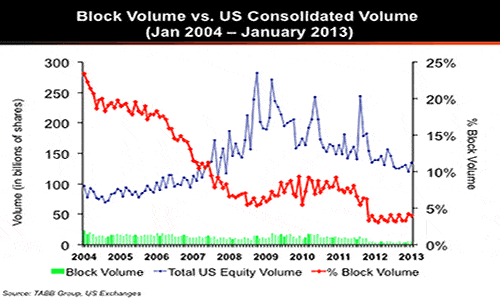The New York Stock Exchange's closure of its dark pool joint venture with BIDS Trading, offers further evidence of the challenges faced by venues that attempt to cross blocks for the buy-side.
The New York Block Exchange (NYBX), which launched just over four years ago, will cease trading on 28 February because the non-displayed trading venue "has not garnered enough volume to achieve critical mass", according to a filing with the Securities and Exchange Commission.
The NYBX anonymously matches block orders by aggregating displayed liquidity, reserve orders and hidden interest on the NYSE order book as well as flow available on BIDS, a dark pool backed by some of the largest US investment banks.
According to Jamie Selway, managing director at ITG, an agency broker that runs the POSIT suite of crossing tools, the value of NYBX may have diminished since its initial launch in 2009.
"The NYBX model was probably more interesting to the market a few years ago when BIDS was newer and trying to establish relationships," Selway said. "Moreover, NYSE isn't typically viewed as a natural aggregator of block liquidity, more a provider of fast and cheap limit order book flow."
While the buy-side still welcomes the opportunity to cross stock in size, block matching rates are typically low (see figure below).

According to data from boutique US broker Rosenblatt Securities, buy-side-only crossing network Liquidnet traded 0.16% of overall US share volumes in December. ITG's POSIT traded an estimated 0.76% of US shares in the same month, 30% of which came from trades in its own buy-side block market POSIT Alert, while BIDS traded 0.48%. By comparison, the largest US dark pool, Credit Suisse's Crossfinder, had a 1.71% share of trading.
Part of the reason low block crossing rates, explains Mark Kuzminskas, head of equity trading at Robeco Investment Management, lies with the correlated nature of institutional investors' trading decisions.
"We only tend to use block trading venues when we have confidence that the buy/sell imbalance will work in our favour," he told theTRADEnews.com. "Most of the time there are limited opportunities to cross block orders, so like most institutional trading firms we will tend to work orders through the market piece by piece."
Kuzminskas pointed out the evolution of market structure and shrinking buy-side commission wallet also hampers block trading.
"It's hard for any buy-side only venue to gain a critical mass in block trades right now, given that some institutions have to pay commissions to particular brokers as well as the fact that most orders are naturally sliced up into smaller pieces," he said.
According to the Rosenblatt figures, the average trade size in US dark pools continues to decline. In March 2009, the average dark pool trade comprised 443 shares, more than double the 203 shares recorded in December 2012. By comparison, the average trade size in Liquidnet was just under 42,000 and 32,000 in POSIT Alert in December 2012.
Partly in response to the decline of block trading opportunities, brokers are beginning to offer capital commitment to their buy-side clients in new ways.
"Brokers are beginning to put their balance sheets forward and are coming up with new innovative, automated solutions to help the buy-side trade on risk," said Cheyenne Morgan, analyst at TABB Group. "Brokers are probably in the best position to help the buy-side trade blocks given the flow they hold internally and the differences in the regulations they are subject to, compared to trading venues."
